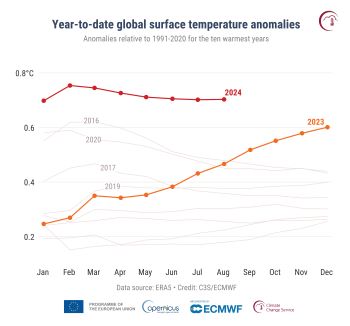Copernicus says Summer 2024 was hottest on record globally and for Europe
- September 9, 2024
- Posted by: Elaine Coles
- Category: Global, Reports, Water Issues, Europe

The Copernicus Climate Change Service (C3S), implemented by the European Centre for Medium-Range Weather Forecasts on behalf of the European Commission with funding from the EU, is reporting that the global-average temperature for the past 12 months (September 2023 – August 2024) is the highest on record for any 12-month period,
C3S has also reported that August 2024 was the joint-warmest August globally (together with August 2023), with an average ERA5 surface air temperature of 16.82°C, 0.71°C above the 1991-2020 average for August.
August 2024 was 1.51°C above the pre-industrial level and is the 13th month in a 14-month period for which the global-average surface air temperature exceeded 1.5°C above pre-industrial levels.
The global-average temperature for the past 12 months (September 2023 – August 2024) is the highest on record for any 12-month period, at 0.76°C above the 1991–2020 average and 1.64°C above the 1850–1900 pre-industrial average. These values are identical to those recorded for the previous two 12-month periods, ending in June and July 2024.
The year-to-date (January–August 2024) global-average temperature anomaly is 0.70°C above the 1991-2020 average, which is the highest on record for this period and 0.23°C warmer than the same period in 2023.
The average anomaly for the remaining months of this year would need to drop by at least 0.30°C for 2024 not to be warmer than 2023. This has never happened in the entire ERA5 dataset, making it increasingly likely that 2024 is going to be the warmest year on record.
Europe and other regions
The average temperature for European land for August 2024 was 1.57°C above the 1991-2020 average for August, making the month the second warmest August on record for Europe after August 2022, which was 1.73°C above average.
European temperatures were most above average over southern and eastern Europe, but below average over northwestern parts of Ireland and the United Kingdom, Iceland, the west coast of Portugal, and southern Norway.
Outside Europe, temperatures were most above average over eastern Antarctica, Texas, Mexico, Canada, northeast Africa, Iran, China, Japan, and Australia.
Temperatures were below average over far eastern Russia and Alaska, the eastern United States, parts of southern South America, Pakistan and the Sahel.
Sea surface temperature
The average sea surface temperature (SST) for August 2024 over 60°S–60°N was 20.91°C, the second-highest value on record for the month, and only 0.07°C below August 2023.
The equatorial Pacific had below-average temperatures, indicating a developing La Niña, but SSTs across the oceans remained unusually high over many regions.
August 2024 – Hydrological highlights:
August 2024 was drier than average over most of continental Europe including southern UK and Ireland, the Alps, the Balkans, northwest Russia and eastern Fennoscandia, with areas in the south and east experiencing drought and wildfires.
Iceland, northern UK and Ireland, much of Fennoscandia, the northern seaboard of continental Europe as well as western Russia and Türkiye saw above-average precipitation, in some cases, leading to floods and damage.
Outside Europe, August 2024 was wetter than average over eastern North America (partly related to Hurricane Debby), central Russia, eastern China, and eastern Australia. The Indian subcontinent was hit by monsoon rains and Cyclone Asna. Heavy rainfall led to flooding in Sudan, Ethiopia and Eritrea. Japan was hit by Typhoon Shanshan.
It was drier than average in Mexico and southern North America, regions of Russia, across China, and most of South America and Southern Africa, with wildfires in Canada, Siberia and Brazil.
August 2024 – Sea Ice highlights

Arctic sea ice extent was 17% below average, ranking fourth lowest for August in the satellite record, distinctly further below average than the same month for the previous three years.
Sea ice concentration anomalies in the Southern Ocean were dominated by much below-average concentrations in the Indian Ocean sector and much above-average concentrations in the Weddell Sea.
Antarctic sea ice extent was 7% below average, the second-lowest extent for August in the satellite data record, behind the -12% August value observed in 2023.
Sea ice concentration anomalies were below average across virtually all of the Arctic Ocean.
2024 Boreal Summer Seasonal Highlights
The global-average temperature for boreal summer (June–August) 2024 was the highest on record at 0.69°C above the 1991-2020 average for these three months, surpassing the previous record from June–August 2023 (0.66°C).
The average temperature for European land for summer (June-August) 2024 was the highest on record for the season at 1.54°C above the 1991-2020 average, exceeding the previous record from 2022 (1.34°C).
Summer 2024 was predominantly wetter than average in western and northern Europe.
Most of the Mediterranean region and Eastern Europe saw drier-than-average conditions throughout the season, in some cases associated to drought.
C3S routinely publishes monthly climate bulletins reporting on the changes observed in global surface air and sea temperatures, sea ice cover and hydrological variables. Additionally, the bulletin also includes highlights regarding the boreal summer (June-July-August). Most of the reported findings are based on the ERA5 reanalysis dataset, using billions of measurements from satellites, ships, aircraft and weather stations around the world.
Copernicus is a component of the European Union’s space programme, with funding by the EU, and is its flagship Earth observation programme, which operates through six thematic services: Atmosphere, Marine, Land, Climate Change, Security and Emergency.
It delivers freely accessible operational data and services providing users with reliable and up-to-date information related to the planet and its environment.
“Temperature-related extreme events witnessed this summer will only become more intense”
Samantha Burgess, Deputy Director of the Copernicus Climate Change Service (C3S) commented:
“During the past three months of 2024, the globe has experienced the hottest June and August, the hottest day on record, and the hottest boreal summer on record. This string of record temperatures is increasing the likelihood of 2024 being the hottest year on record. The temperature-related extreme events witnessed this summer will only become more intense, with more devastating consequences for people and the planet unless we take urgent action to reduce greenhouse gas emissions.”
